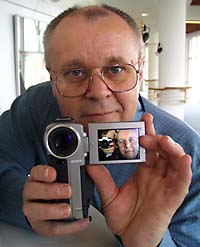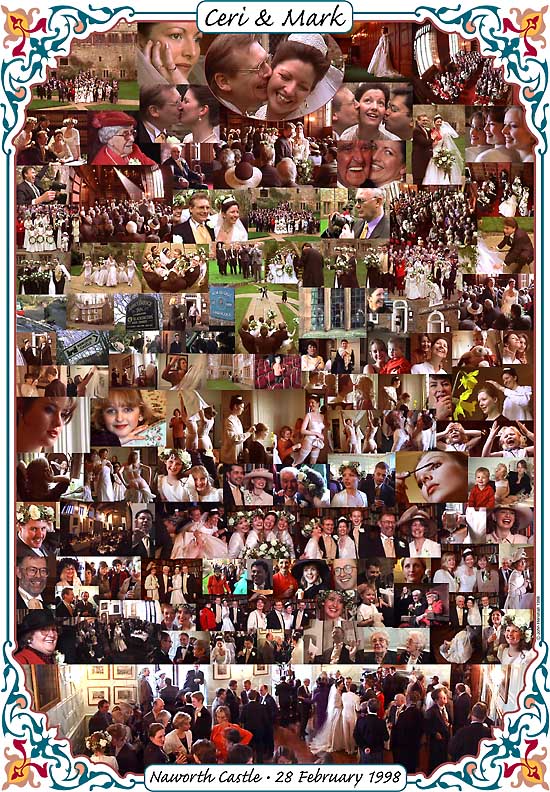
by John Henshall

by John Henshall
NOTE: This article cantains only two images, one of which is large -- 167KB. Although we have compressed this 550x792 pixel image as much as possible, it still breaks our house rules for small image file sizes. Unfortunately, there is no alternative: we have not provided a thumbnail since the image itself already contains over a hundred thumbnails! The image is located near the end of the text so it should download by the time you read the article. Otherwise, we hope you'll find the wait rewarding.
Keith Thompson is a photographer who leads -- never follows -- fashions and innovations. Strikingly individualistic, he works only with his wife Debbie, preferring to avoid cliques and the stereotyped approach. He wins many awards and, even more importantly, wins many clients. In short, he is one of Britain's most successful social photographers.
Typical of his lateral approach, Keith phoned me after reading Chip Shop in January 1998, to ask whether my Sony DCR-PC7 digital camcorder and Radius PhotoDV would be suitable for capturing candid pictures at weddings. The outcome of the call was an invitation to me to work with him, as a test, at a big wedding in a castle near Carlisle at the end of February. I grasped the offer with enthusiasm - and apprehension at the thought of working alongside one of our finest wedding photographers. I need not have worried. Keith and Debbie know how to make everyone feel at ease.
The wedding of Ceri Laidler and Mark Rocca took place at Naworth Castle, twelve miles north east of Carlisle. The location is stunning. Naworth was a Border fortress, built in 1335 by the Dacre family, inherited and renovated in 1602 by the Howards. Now owned by Philip Howard, son of the late 12th Earl of Carlisle, Naworth is a major function venue, film location and one of the few Border castles licensed for civil marriages. Wedding ceremonies take place in the Old Library, the wedding breakfast in the beautiful Great Hall which seats up to 200 guests, whilst the oldest room in the castle -- Lord William Howard's sixteenth century bedroom -- is the bridal suite.
Lighting conditions in the castle rooms and corridors were interesting mixtures of tungsten with daylight flooding in through the windows. Outside, in the castle courtyard, the winter light was restricted all around by the high castle walls, leaving everyone top lit -- a difficult situation for my Sony DCR-PC7's auto exposure. But the PC7's fold-out LCD viewfinder is excellent, enabling me to use a monopod as a camera crane, to get really high shots and still see what I am shooting. It also makes it easy to shoot from floor level, without lying down.
At first, I kept wanting to develop shots and sequences as though I was shooting for television. Old habits die hard but I knew what I really needed were steady shots, from which individual stills could be captured. In effect, I was using the digital video camera as a 25 fps motor drive stills camera with a storage capacity of nearly 95,000 images on each tape. In all I shot over two hours -- almost 200,000 images.
Keith enjoys every minute of his work and his unassuming professional presence fitted the day perfectly. We were treated like good friends of the Laidler family. The photographic presence also provided a kind of media attention, which served to heighten the occasion. Debbie's attention to detail is awesome. She was always on hand, anticipating everything -- right down to the hot water bottle to stop the bride catching pneumonia in the sub-zero temperature outside. We started shooting before breakfast, finishing after nine in the evening, then Keith drove home, through a blizzard over Shap, dropping me off at three the next morning. Knowing his fee, I also know that it is a bargain for the phenomenal amount of energy, skill, equipment, materials, time and pre- and post-production involved.
Back in my studio I had the considerable problem of selecting fewer than 100 images from the 200,000 on tape. And how would I combine all these images into a digital collage?
Photoshop would allow me to move and change images if I used the 'layers' function but it would become a very big file with all those images and layers. So I used QuarkXPress instead, making the page up at A2 (42 x 59.4 cm, 16 x 23 inches) as though it was a very large magazine page. The border (it was easy to resist one with silver wedding bells) is an EPS file, which means it can be enlarged to the size of a football pitch and still remain sharp. The same goes for the lettering, but not the images, which are retained as individual TIFF files.
Each image took less than two seconds to acquire from the camera using Radius PhotoDV. Without this superb piece of kit and software the job would have been almost impossible. I had to colour balance the images because the Sony DCR-PC7 has a mind of its own, adjusting white balance and gamma as it detects changes in the mixed lighting. It would have been better had I been able to set and hold a white balance mid-way between daylight and tungsten but that's asking a lot &emdash; this is only a pocket camcorder. Maybe one of the three-chip semi-pro camcorders would be better for this kind of work?
Each image was imported into a QuarkXPress image box, which could then be sized, changed and moved around at will -- and have a border of any colour. To select and acquire just over a hundred images and make them up into the page took me the whole of one day and night before I went to Austria to speak at the World Council of Professional Photographers' Congress.
I wanted to print the collage on standard photographic paper, so I sent the file to Dunn's Professional Imaging in Birmingham by ISDN. Dunn's make outstanding photographic prints from digital files using their new Kodak LED 20P digital printer. (See Chip Shop November 1997.) Unfortunately you can't print a QuarkXPress file on the LED printer yet, though Dunn's say they are expecting a RIP (Raster Image Processor) from Kodak some day. The work-round was to save the Quark file as an EPS (Encapsulated PostScript) and then open that in Adobe Photoshop at the size required. This works perfectly. The EPS file, combining images, text and design elements, was 80MB. Rasterised in Photoshop at 250 pixels per inch (the resolution of the Kodak LED 20P), the A2 file became 65MB. Saving in Photoshop file format brought the advantage of some non-lossy compression, which reduced the saved file to 43MB. This took just under fifty minutes to transmit by ISDN. Normally I'd have done this after six in the evening, for a call charge of about £2, but this time I had to do it during the day. Nice for British Telecom and still less expensive and time consuming than writing a CD and posting it.

I'm pleased to say that the finished print was well received, both here and in Austria. It's invaluable to be able to test new techniques in a real-life situations. The process should be much easier and quicker next time so I would like to do more, if Keith is agreeable. In the meantime, thank you Keith and Debbie. I never realised that wedding photography could be so enjoyable.